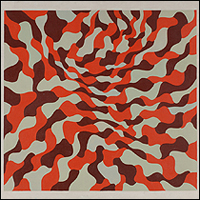![]()
1
+ X= GROUPS, TEAMS AND COLLECTIVES
Opening: Jul
17, 2014, at 20:00 h.
Date: Jul 18 - November 2, 2014
Place: South Cloister 1
Exhibition Session: The Common
Works by:
AFAL (Paco Gómez, Oriol Maspons, Francisco Ontañón) · Bleda
y Rosa · Centro de Cálculo (Elena Asins, Manuel Barbadillo,
Gerardo Delgado, Manolo Quejido, Soledad Sevilla, José María Yturralde)
· Costus · Documenta 6 Satellite Telecast (Joseph
Beuys, Douglas Davis, Nam June Paik) · Equipo 57 ·
Equipo Crónica · Equipo Múltiple · Figura ·
Flo6x8 · Libia Castro y Ólafur Ólafsson · MP&MP Rosado
· Separata · USCO · Zemos98
Throughout history in general, and art history in particular,
collaboration and knowledge pooling among different individuals
and groups has been a more common practice than we are generally
led to believe. Over the past decade, with the spread of the internet
and Web 2.0, we have witnessed an expansion of the concept of "collective
intelligence", a communal knowledge-building method predicated on
the fact that intelligence "is everywhere". In his well-known essay
on this subject, Pierre Lévy notes that "the basis and goal of collective
intelligence is the mutual recognition and enrichment of individuals".
This has become the norm for art in recent decades, a fact borne
out by the works that the Centro Andaluz de Arte Contemporáneo has
added to its collection over the years.
In contrast to the virtues of individuality and genius extolled by Romanticism, historically artistic knowledge has always been collective, a product of workshops and the transmission of know-how, forms and styles. The avant-garde artists of the early 20th century and the postwar years frequently participated in collaborative projects, formed artistic groups and pooled their creative forces to bring about cultural and social transformation. That need to work with others endured and was expressed in different ways over the last several decades, until the new tools of the knowledge society finally triggered the explosion of collaborative strategies we are witnessing today.
The "X" in the exhibition title is a number variable which, when added to individuality, allows us to speak of groups, associations, teams, collectives, etc. Interestingly, the oldest work in the CAAC Collection is by Equipo 57, a team that in its day attempted to break away from the subjective vision of the individual artist and move towards another form of organization. Two other groups are also represented in the exhibition and the collection: Equipo Crónica with their political Pop Art, and Equipo Múltiple out of Seville.
Journals founded by artists have often been one of the most fertile arenas for collaboration. AFAL brought together a considerable number of photographers who were active in Spain in the 1950s and 60s; Separata, published in the late 1970s and early 80s, united artists, writers, philosophers and architects; and in the 1980s Figura was the catalyst of an entire generation.
At other times, technological innovations have served to unite artists on team projects. This was the case of the Computing Centre, where the new possibilities of computerization released a torrent of creative magma. And further north, at Documenta 6 in Germany, artists like Joseph Beuys, Nam June Paik and Douglas David participated in the first satellite telecasts.
More recently, in the last ten years, we might say that collaborative processes have split into two different categories. On the one hand we have collectives or groups for whom the tools of the information society are central to their conceptualization and modus operandi, such as Zemos98 or, with their original take on political action, Flo6x8. On the other we find artists whose involvement in collaborative processes stems from personal bonds of affection and identity, exemplified by Costus, Bleda y Rosa, MP&MP Rosado or Libia Castro and Ólafur Ólafsson.
| ADDITIONAL DOCUMENTATION |


